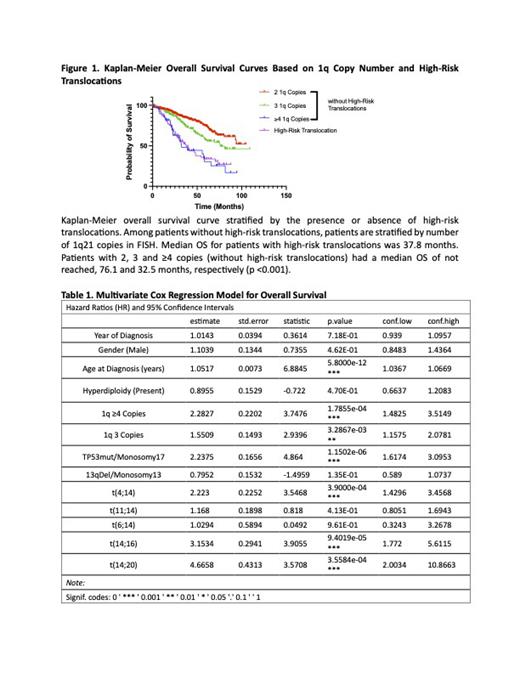Introduction
Fluorescent In-Situ Hybridization (FISH) has been an indispensable tool to characterize the cytogenetic landscape of multiple myeloma (MM), mainly for identifying primary abnormalities such as heavy chain gene (IgH) translocations and odd-number chromosome trisomies. These aberrations play a crucial role in risk stratifying the disease given their correlation with disease aggressiveness, treatment response and overall prognosis. High-risk (HR) cytogenetics are identified through the presence of t(14;16), t(14;20) or loss of the p53 gene locus. Less is known about the prognostic implication of secondary abnormalities, in particular gain of 1q21. We aimed to evaluate the association between primary and secondary cytogenetic abnormalities and their impact on overall survival (OS) in MM patients.
Methods
We performed a retrospective analysis on a FISH records database from three Mayo Clinic campuses. Cohort included patients >18 years of age, diagnosed with multiple myeloma between 2005 and 2022, with FISH performed within two years of diagnosis. Demographics including age, date of diagnoses and OS data were retrieved from electronic medical records. Statistical analyses were done using BlueSky Statistics software. Study was conducted in accordance with the principles of the Declaration of Helsinki; informed consent was obtained from all participants.
Results
We analyzed a total of 2221 patients, among which 59.8% were male, with a median age of diagnosis 65 years. Hyperdiploidy was the most prevalent primary cytogenetic abnormality observed in 44.3% of patients, followed by t(11;14) as the most common translocation (23%), and t(4;14) (8.2%). Gain(1q21) was assessed in 925 patients, among which 64%, 30.3% and 5.7% had 2, 3 and ≥4 copies respectively. Furthermore, 11.4% (n=253) exhibited either mutated TP53 or del17p, and 37.8% (n=839) presented with 13q loss or monosomy 13. The median follow-up for the overall population was 102 months (8.5 years), with a median OS of 75.5 months. Patients with high-risk translocations had significantly shorter median OS of 40.01 months compared to 80.65 months for those with standard risk translocations (p <0.001). The presence of ≥4 1q copies was associated with significantly reduced overall survival (2 copies: not reached, 3 copies: 69.4 months, ≥4 copies: 40.1774; p <0.001). This was consistent even when considering the presence of high-risk translocations (Figure 1).
To confirm the independent significance of these findings, we performed multivariate Cox regression models, incorporating age at diagnosis, year of diagnosis, gender, presence of hyperdiploid disease, and presence of high-risk translocations. Given that overall survival outcomes were analyzed irrespective of treatment received, we incorporated year of diagnosis as a variable to control for potential impact of evolving treatment regimens over the years. The presence of ≥4 1q copies was associated with reduced OS, with a hazard ratio (HR) of 2.12 (CI: 1.38-3.26; p <0.001). The presence of 3 copies also showed prognostic significance (HR: 1.43; p: 0.012). Similarly, both the presence of TP53mut/mon17 (HR: 1.96, CI: 1.66-2.31; p <0.001) and 13qdel/mon13 (HR: 1.21, CI: 1.08-1.38) were associated with decreased OS. On the other hand, 1p deletion did not have any significant prognostic implications (HR: 1.84, CI: 0.38-1.59; p 0.113). When incorporating all cytogenetic events into a multivariate model, variables associated with reduced OS included age at diagnosis, the presence of both of 3 and ≥4 1q copies, TP53mut/mon17, t(4;14), t(14;16) and t(14;20). However, 13qDel/mon13 lost significance when incorporated with other abnormalities (Table 1).
Conclusion
Our investigation sheds light on the less explored realm of secondary cytogenetic abnormalities and confirm a strong association between increasing number of 1q copies and reduced overall survival, independent of other cytogenetic abnormalities and treatment regimens. These results underscore the utility of FISH-based comprehensive cytogenetic profiling at baseline, which enables reliable identification of high-risk patients. Future prospective trials should further elucidate the pathogenic mechanism for these findings. Our analysis used OS as primary endpoint and included over 2000 MM patients, reinforcing the clinical relevance of our findings.
Disclosures
Bergsagel:Janssen: Consultancy; Pfizer: Research Funding; Mayo Clinic: Patents & Royalties: Royalty for hCRBN and Vk*MYC mice; Aptitude Health: Honoraria; CellCentric: Consultancy; Salarius: Consultancy; Novartis: Patents & Royalties: Royalty for hCRBN mice; Omeros: Consultancy; Radmetrix: Consultancy. Fonseca:Aztrazenica: Consultancy; Bayer: Consultancy; AMGEN: Consultancy; Adaptive Biotechnologies: Consultancy; AbbVie: Consultancy; Binding Site: Consultancy; BMS (Celgene): Consultancy; Millenium: Consultancy; Takeda: Consultancy; Janssen: Consultancy; Juno: Consultancy; Kite: Consultancy; Merck: Consultancy; Pfizer: Consultancy; Pharmacyclics: Consultancy; Regeneron: Consultancy; Sanofi: Consultancy; Adaptive Biotechnologies: Membership on an entity's Board of Directors or advisory committees; Caris Life Sciences: Membership on an entity's Board of Directors or advisory committees; Oncotracker: Membership on an entity's Board of Directors or advisory committees; Antegene: Membership on an entity's Board of Directors or advisory committees; AZBio: Membership on an entity's Board of Directors or advisory committees; FISH: Patents & Royalties: FISH.


This feature is available to Subscribers Only
Sign In or Create an Account Close Modal